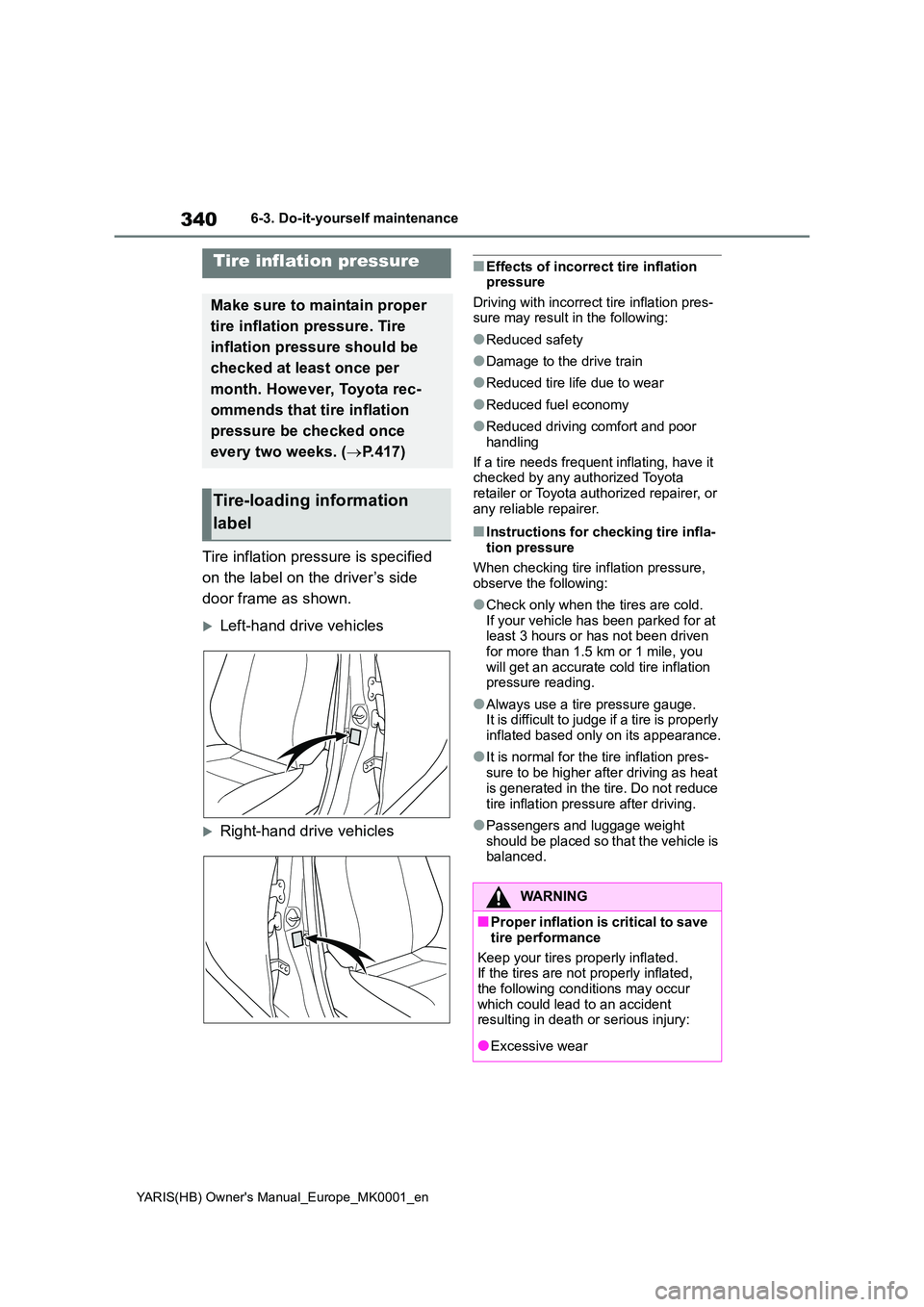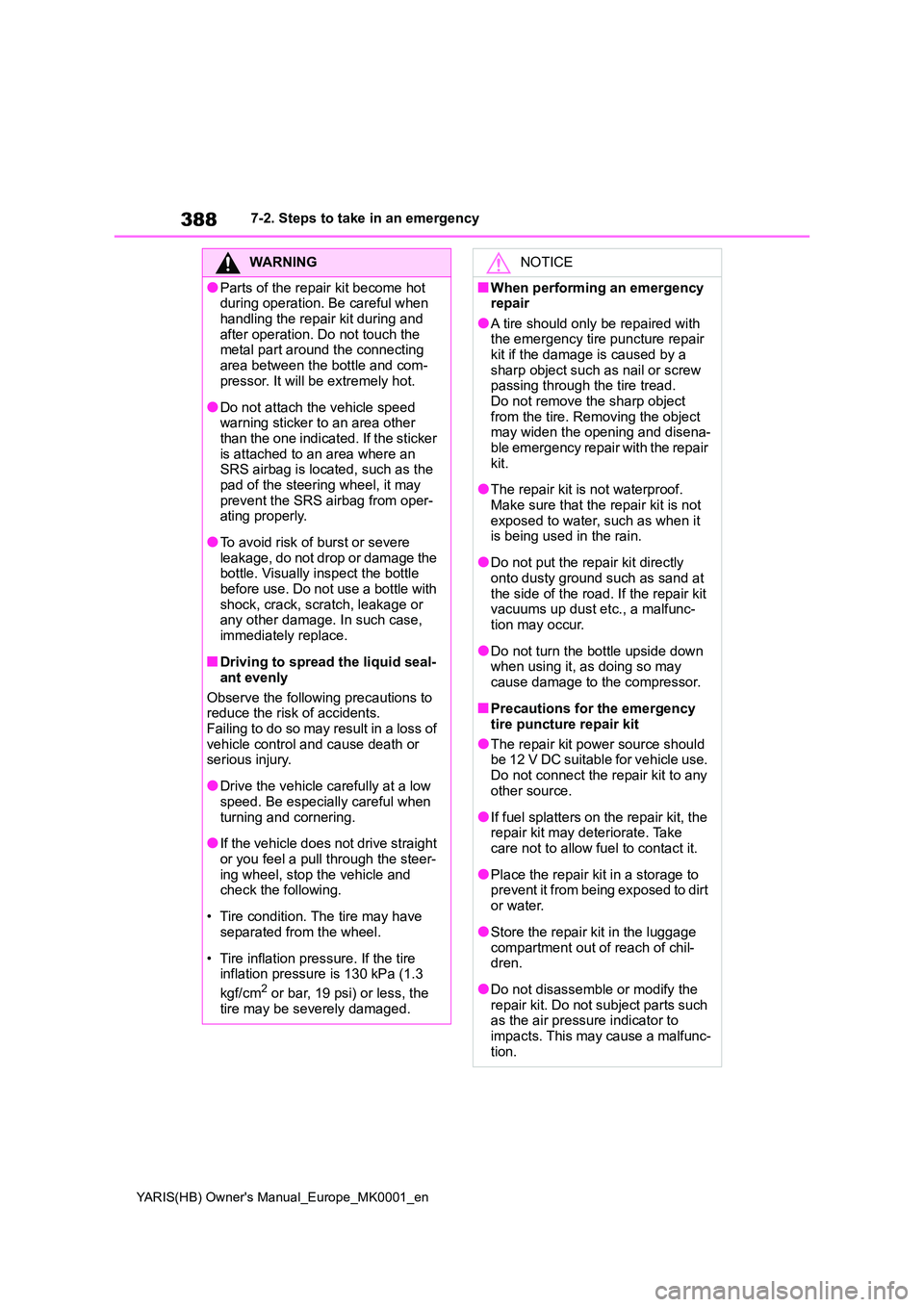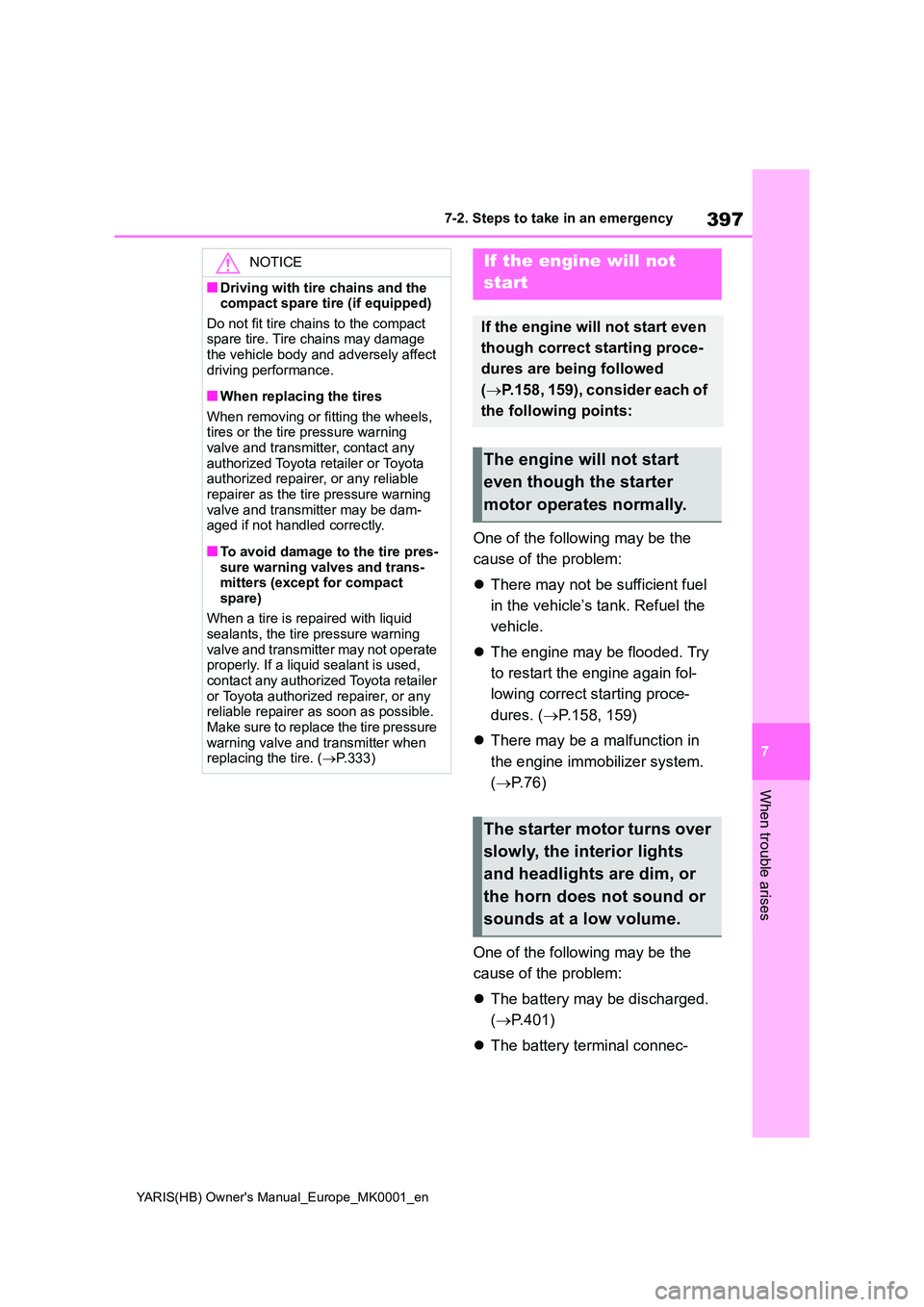2021 TOYOTA YARIS HATCHBACK fuel pressure
[x] Cancel search: fuel pressurePage 1 of 568

1
6
5
4
3
2
7
YARIS(HB) Owner's Manual_Europe_MK0001_en
8
Pictorial indexSearch by illustration
For safety
and security
Make sure to read through them
(Main topics: Child seat, theft deterrent system)
Vehicle status
information and
indicators
Reading driving-related information
(Main topics: Meters, multi-information display)
Before driving
Opening and closing the doors and windows, adjustment
before driving
(Main topics: Keys, doors, seats, power windows)
DrivingOperations and advice which are necessary for driving
(Main topics: Starting engine, refueling)
Interior featuresUsage of the interior features
(Main topics: Air conditioner, storage features)
Maintenance
and care
Caring for your vehicle and maintenance procedures
(Main topics: Interior and exterior, light bulbs)
When trouble
arises
What to do in case of malfunction and emergency
(Main topics: Battery discharge, flat tire)
Vehicle
specifications
Vehicle specifications, customizable features
(Main topics: Fuel, oil, tire inflation pressure)
IndexSearch by symptom
Search alphabetically
Page 13 of 568

13
YARIS(HB) Owner's Manual_Europe_MK0001_en
Pictorial index
Refueling method .............................................................................P.187
Fuel type/fuel tank capacity .............................................................P.413
Tires ................................................................................................P.330
Tire size/inflation pressure ...............................................................P.417
Winter tires/tire chains .....................................................................P.274
Checking/rotation/tire pressure warning system ..............................P.330
Coping with flat tires.................................................................P.379, 389
Hood ................................................................................................P.317
Opening ...........................................................................................P.317
Engine oil .........................................................................................P.413
Coping with overheating ..................................................................P.405
Headlights/front position lights/daytime running lights/turn signal
lights .......................................................................................P.171, 173
Front fog lights
*2............................................................................P.180
Tail lights/turn signal lights ..................................................P.171, 173
Stop lights
Side turn signal lights ...................................................................P.171
License plate light..........................................................................P.173
Rear fog light ..................................................................................P.180
Back-up light
Shifting the shift position to R ..................................................P.164, 168
*1: Vehicles with a smart entry & start system
*2: If equipped
Light bulbs of the exterior lights for driving
(Replacing method: P.351, Watts: P.419)
Page 83 of 568

83
2
YARIS(HB) Owner's Manual_Europe_MK0001_en
2-1. Instrument cluster
Vehicle status information and indicators
Warning lights inform the driver of
malfunctions in the indicated vehi-
cle’s systems.
*1: These lights come on when the
engine switch is turned to ON to indi-
cate that a system check is being
performed. They will turn off after the
engine is started, or after a few sec-
onds. There may be a malfunction in
a system if the lights do not come
on, or turn off. Have the vehicle
inspected by any authorized Toyota
retailer or Toyota authorized repairer,
or any reliable repairer.
*2: This light illuminates on the multi-
information display.
Warning lights
Brake system warning light*1
(→P.368)
High coolant temperature
warning light
*2 (→P.368)
Charging system warning
light
*2 (→P.368)
Low engine oil pressure
warning light
*2 (→P.369)
Malfunction indicator lamp
*1
(→P.369)
SRS warning light
*1
(→P.369)
ABS warning light
*1
(→P.369)
Brake Override System
warning light/Drive-Start
Control warning light
*2
(→P.370)
(Red)
Electric power steering sys-
tem warning light
*1 (→P.370)
(Yellow)
Electric power steering sys-
tem warning light
*1 (→P.370)
Low fuel level warning light
(→P.371)
Driver’s and front passen-
ger’s seat belt reminder light
(→P.371)
Rear passengers’ seat
belt reminder lights
*2
(→P.371)
Tire pressure warning light
*1
(→P.372)
(Orange)
LTA i n d i c a t o r*2 (if equipped)
(→P.372)
(Flashes)
Stop & Start cancel indica-
tor
*1 (if equipped) (→P.372)
(Flashes)
Toyota parking assist-sensor
OFF indicator
*1 (if equipped)
(→P.373)
(Flashes)
“RCTA OFF” indicator*1 (if
equipped) (→P.373)
PKSB OFF indicator
*1 (if
equipped) (→P.373)
(Flashes or
illuminates)
PCS warning light*1 (if
equipped) (→P.374)
Slip indicator
*1 (→P. 3 7 4 )
Page 340 of 568

340
YARIS(HB) Owner's Manual_Europe_MK0001_en
6-3. Do-it-yourself maintenance
Tire inflation pressure is specified
on the label on the driver’s side
door frame as shown.
Left-hand drive vehicles
Right-hand drive vehicles
■Effects of incorrect tire inflation pressure
Driving with incorrect tire inflation pres- sure may result in the following:
●Reduced safety
●Damage to the drive train
●Reduced tire life due to wear
●Reduced fuel economy
●Reduced driving comfort and poor
handling
If a tire needs frequent inflating, have it checked by any authorized Toyota
retailer or Toyota authorized repairer, or any reliable repairer.
■Instructions for checking tire infla-tion pressure
When checking tire inflation pressure, observe the following:
●Check only when the tires are cold.If your vehicle has been parked for at least 3 hours or has not been driven
for more than 1.5 km or 1 mile, you will get an accurate cold tire inflation pressure reading.
●Always use a tire pressure gauge.It is difficult to judge if a tire is properly
inflated based only on its appearance.
●It is normal for the tire inflation pres-
sure to be higher after driving as heat is generated in the tire. Do not reduce
tire inflation pressure after driving.
●Passengers and luggage weight
should be placed so that the vehicle is balanced.
Tire inflation pressure
Make sure to maintain proper
tire inflation pressure. Tire
inflation pressure should be
checked at least once per
month. However, Toyota rec-
ommends that tire inflation
pressure be checked once
every two weeks. ( →P.417)
Tire-loading information
label
WARNING
■Proper inflation is critical to save
tire performance
Keep your tires properly inflated. If the tires are not properly inflated,
the following conditions may occur which could lead to an accident resulting in death or serious injury:
●Excessive wear
Page 388 of 568

388
YARIS(HB) Owner's Manual_Europe_MK0001_en
7-2. Steps to take in an emergency
WARNING
●Parts of the repair kit become hot during operation. Be careful when
handling the repair kit during and after operation. Do not touch the metal part around the connecting
area between the bottle and com- pressor. It will be extremely hot.
●Do not attach the vehicle speed warning sticker to an area other than the one indicated. If the sticker
is attached to an area where an SRS airbag is located, such as the pad of the steering wheel, it may
prevent the SRS airbag from oper- ating properly.
●To avoid risk of burst or severe leakage, do not drop or damage the bottle. Visually inspect the bottle
before use. Do not use a bottle with shock, crack, scratch, leakage or any other damage. In such case,
immediately replace.
■Driving to spread the liquid seal-
ant evenly
Observe the following precautions to reduce the risk of accidents.
Failing to do so may result in a loss of vehicle control and cause death or serious injury.
●Drive the vehicle carefully at a low speed. Be especially careful when
turning and cornering.
●If the vehicle does not drive straight
or you feel a pull through the steer- ing wheel, stop the vehicle and check the following.
• Tire condition. The tire may have separated from the wheel.
• Tire inflation pressure. If the tire inflation pressure is 130 kPa (1.3
kgf/cm2 or bar, 19 psi) or less, the tire may be severely damaged.
NOTICE
■When performing an emergency repair
●A tire should only be repaired with the emergency tire puncture repair kit if the damage is caused by a
sharp object such as nail or screw passing through the tire tread.Do not remove the sharp object
from the tire. Removing the object may widen the opening and disena-ble emergency repair with the repair
kit.
●The repair kit is not waterproof.
Make sure that the repair kit is not exposed to water, such as when it is being used in the rain.
●Do not put the repair kit directly onto dusty ground such as sand at
the side of the road. If the repair kit vacuums up dust etc., a malfunc-tion may occur.
●Do not turn the bottle upside down when using it, as doing so may
cause damage to the compressor.
■Precautions for the emergency
tire puncture repair kit
●The repair kit power source should be 12 V DC suitable for vehicle use.
Do not connect the repair kit to any other source.
●If fuel splatters on the repair kit, the repair kit may deteriorate. Take care not to allow fuel to contact it.
●Place the repair kit in a storage to prevent it from being exposed to dirt
or water.
●Store the repair kit in the luggage
compartment out of reach of chil- dren.
●Do not disassemble or modify the repair kit. Do not subject parts such as the air pressure indicator to
impacts. This may cause a malfunc- tion.
Page 397 of 568

397
7
YARIS(HB) Owner's Manual_Europe_MK0001_en
7-2. Steps to take in an emergency
When trouble arises
One of the following may be the
cause of the problem:
�z There may not be sufficient fuel
in the vehicle’s tank. Refuel the
vehicle.
�z The engine may be flooded. Try
to restart the engine again fol-
lowing correct starting proce-
dures. ( →P.158, 159)
�z There may be a malfunction in
the engine immobilizer system.
( →P. 7 6 )
One of the following may be the
cause of the problem:
�z The battery may be discharged.
( →P.401)
�z The battery terminal connec-
NOTICE
■Driving with tire chains and the compact spare tire (if equipped)
Do not fit tire chains to the compact spare tire. Tire chains may damage the vehicle body and adversely affect
driving performance.
■When replacing the tires
When removing or fitting the wheels, tires or the tire pressure warning valve and transmitter, contact any
authorized Toyota retailer or Toyota authorized repairer, or any reliable repairer as the tire pressure warning
valve and transmitter may be dam- aged if not handled correctly.
■To avoid damage to the tire pres-sure warning valves and trans-mitters (except for compact
spare)
When a tire is repaired with liquid sealants, the tire pressure warning
valve and transmitter may not operate properly. If a liquid sealant is used, contact any authorized Toyota retailer
or Toyota authorized repairer, or any reliable repairer as soon as possible. Make sure to replace the tire pressure
warning valve and transmitter when replacing the tire. ( →P.333)
If the engine will not
start
If the engine will not start even
though correct starting proce-
dures are being followed
( →P.158, 159), consider each of
the following points:
The engine will not start
even though the starter
motor operates normally.
The starter motor turns over
slowly, the interior lights
and headlights are dim, or
the horn does not sound or
sounds at a low volume.
Page 558 of 568

558
YARIS(HB) Owner's Manual_Europe_MK0001_en
Alphabetical Index
Warning light .............................. 369
Engine oil maintenance data ....... 323
Engine switch ....................... 158, 159
Auto power off function .............. 162
Changing the engine switch modes
......................................... 158, 162
If your vehicle has to be stopped in
an emergency .......................... 360
EPS (Electric Power Steering) ..... 269
Warning light .............................. 370
F
Flat tire
Tire pressure warning system .... 332
Vehicles with a spare tire ........... 389
Vehicles without a spare tire ...... 379
Floor mats ....................................... 30
Fluid
Brake.......................................... 417
Clutch ......................................... 417
Multidrive.................................... 416
Washer ....................................... 329
Fog lights
Replacing light bulbs .......... 351, 352
Switch ........................................ 180
Wattage ...................................... 419
Front fog lights
Replacing light bulbs .......... 351, 352
Switch ........................................ 180
Wattage ...................................... 419
Front position lights
Replacing light bulbs .......... 351, 352
Wattage ...................................... 419
Front seat center airbags............... 36
Front seats .................................... 128
Adjustment ................................. 128
Cleaning ..................................... 311
Correct driving posture................. 31
Head restraints........................... 130
Seat heaters............................... 289
Front turn signal lights ................ 171Replacing light bulbs ..........351, 352
Turn signal lever ......................... 171
Wattage ...................................... 419
Fuel ................................................ 186
Capacity ..................................... 413
Fuel gauge ............................. 86, 90
Fuel pump shut off system ......... 367
Information ................................. 420
Refueling .................................... 186
Type ........................................... 413
Warning light .............................. 371
Fuel consumption
Average fuel economy .........95, 100
Current fuel consumption .....95, 100
Fuel economy..........................95, 100
Fuel filler door ............................... 186
Refueling .................................... 186
Fuel gauge ................................. 86, 90
Fuel pump shut off system .......... 367
Fuses ............................................. 348
G
Gauges....................................... 86, 90
Gear Shift Indicator ...................... 170
Glove box ...................................... 293
GPF (Gasoline Particulate Filter)
system ......................................... 267
Grocery bag hooks .......................295
H
Head restraints.............................. 130
Head-up display ............................ 105
Driving information display area .105
Driving support system display area
................................................. 107
Eco Driving Indicator ..................108
Navigation system-linked display
area .......................................... 107
Pop-up display ........................... 107
Settings ...................................... 106
Page 561 of 568

561
YARIS(HB) Owner's Manual_Europe_MK0001_en
Alphabetical Index
Eco Driving Indicator ............ 95, 101
Fuel economy ...................... 95, 100
LTA (Lane-Tracing Assist) .......... 209
Menu icons............................. 93, 99
Meter control switches ......... 94, 100
Navigation system-linked display96,
102
Settings ................................ 97, 103
Stop & Start system information 98,
104
Tire pressure .............................. 332
Toyota parking assist-sensor ..... 242
Vehicle information display .. 97, 102
Warning message ...................... 377
Multidrive ...................................... 164
If the shift lever cannot be shifted
from P ...................................... 165
M mode ...................................... 167
Paddle shift switches ................. 166
N
Navigation system-linked display96,
102, 105
O
Odometer .................................. 87, 91
Odometer and trip meter display
Display change button ........... 87, 91
Display items.......................... 87, 91
Oil
Engine oil ................................... 413
Manual transmission .................. 416
Opener
Back door ................................... 122
Fuel filler door ............................ 186
Hood .......................................... 317
Outside rear view mirrors
Adjustment ................................. 136
BSM (Blind Spot Monitor) .......... 237
Folding ....................................... 137Outside rear view mirror defoggers
......................................... 280, 285
RCTA (Rear Crossing Traffic Alert)
................................................. 247
Outside temperature......... 86, 90, 108
Overheating ...................................405
P
Paddle shift switches ................... 166
Panoramic roof shade ..................305
Parking assist sensors (Toyota park-
ing assist-sensor) .......................242
Parking brake ................................ 171
Operation ...................................171
Parking brake engaged warning
buzzer ...................................... 171
Parking Support Brake (PKSB) ... 251
Enabling/disabling the Parking Sup-
port Brake ................................ 252
Parking Support Brake function
(rear-crossing vehicles)............262
Parking Support Brake function
(static objects) .......................... 256
Warning lights.............................373
Warning message ...................... 255
PCS (Pre-Collision System) ......... 193
Enabling/disabling the pre-collision
system...................................... 196
Function ..................................... 193
Warning light .............................. 374
Personal lights .............................. 291
Wattage ...................................... 419
PKSB (Parking Support Brake) ... 251
Enabling/disabling the Parking Sup-
port Brake ................................ 252
Parking Support Brake function
(rear-crossing vehicles)............262
Parking Support Brake function
(static objects) .......................... 256
Warning lights.............................373
Warning message ...................... 255